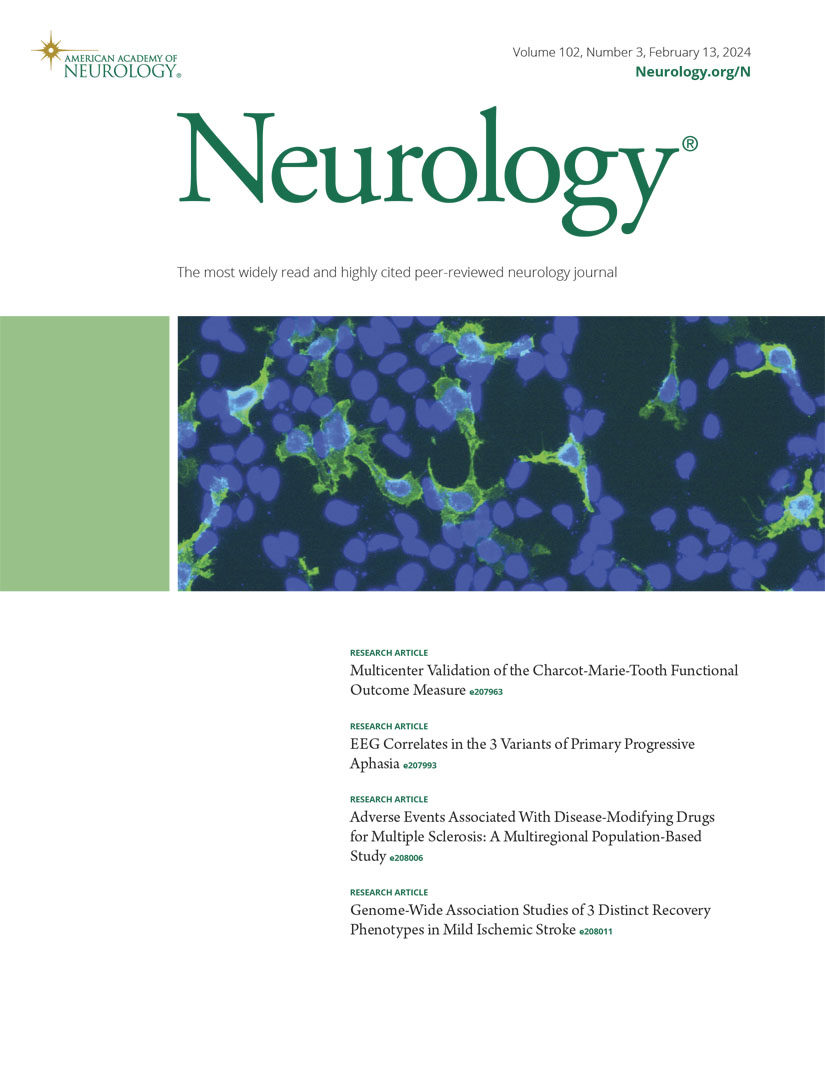Anatomic Staging of H3 G34-Mutant Diffuse Hemispheric Glioma.
IF 7.7
1区 医学
Q1 CLINICAL NEUROLOGY
引用次数: 0
Abstract
OBJECTIVES H3 G34-mutant diffuse hemispheric gliomas are rare, aggressive primary brain tumors predominantly affecting young patients. We investigated the prognostic value of anatomic staging (AS)-a system previously validated in adult-type diffuse gliomas-in this molecularly distinct tumor type. METHODS Patients from an international cohort with H3 G34-mutant gliomas underwent AS based on pretreatment imaging, performed independently by 2 raters blinded to clinical outcomes. Inter-rater reliability was evaluated using Cohen kappa. Kaplan-Meier curves and Cox proportional hazards models-unadjusted and adjusted for sex, extent of resection, and O6-methylguanine DNA-methyltransferase (MGMT) status-were used to analyze overall survival across stages. RESULTS Thirty-seven patients were included (median age 22 years; 54% female). Inter-rater reliability was high (weighted κ = 0.93, 95% CI 0.85-1.0). Median overall survival was 36 months for stage 1 (95% CI 16-67 months), 25 months for stage 2 (95% CI 8-41), and 9 months for stage 3 (95% CI 3-26). After adjustment for sex, extent of resection, and MGMT status, survival differences persisted (hazard ratio [HR]Stage 2 adjusted 2.25, 95% CI 0.67-7.5, p = 0.19; HRStage 3 adjusted 4.37, 95% CI 1.39-13.7, p = 0.01). DISCUSSION AS is reproducible and prognostically relevant for H3 G34-mutant gliomas, providing insights into tumor spread. It may inform treatment decisions, but larger studies are needed to confirm its clinical utility.h3g34突变型弥漫性半球胶质瘤的解剖分期。
目的:h3g34突变型弥漫性半球胶质瘤是一种罕见的侵袭性原发性脑肿瘤,主要影响年轻患者。我们研究了解剖分期(AS)的预后价值,该系统先前在成人型弥漫性胶质瘤中得到验证。方法来自一个国际队列的H3 g34突变胶质瘤患者接受了基于预处理成像的AS,由2名对临床结果盲法的评分者独立进行。评估者间信度采用Cohen kappa法。Kaplan-Meier曲线和Cox比例风险模型(未调整和调整性别、切除程度和o6 -甲基鸟嘌呤dna -甲基转移酶(MGMT)状态)用于分析各阶段的总生存率。结果纳入37例患者(中位年龄22岁;54%的女性)。评估间信度高(加权κ = 0.93, 95% CI 0.85-1.0)。第一阶段的中位总生存期为36个月(95% CI 16-67个月),第二阶段为25个月(95% CI 8-41),第三阶段为9个月(95% CI 3-26)。在调整性别、切除程度和MGMT状态后,生存差异仍然存在(风险比[HR] 2期调整为2.25,95% CI 0.67-7.5, p = 0.19;HRStage 3调整为4.37,95% CI 1.39 ~ 13.7, p = 0.01)。讨论as在h3g34突变胶质瘤中具有可重复性和预后相关性,为肿瘤扩散提供了见解。它可能为治疗决策提供信息,但需要更大规模的研究来证实其临床效用。
本文章由计算机程序翻译,如有差异,请以英文原文为准。
求助全文
约1分钟内获得全文
求助全文
来源期刊

Neurology
医学-临床神经学
CiteScore
12.20
自引率
4.00%
发文量
1973
审稿时长
2-3 weeks
期刊介绍:
Neurology, the official journal of the American Academy of Neurology, aspires to be the premier peer-reviewed journal for clinical neurology research. Its mission is to publish exceptional peer-reviewed original research articles, editorials, and reviews to improve patient care, education, clinical research, and professionalism in neurology.
As the leading clinical neurology journal worldwide, Neurology targets physicians specializing in nervous system diseases and conditions. It aims to advance the field by presenting new basic and clinical research that influences neurological practice. The journal is a leading source of cutting-edge, peer-reviewed information for the neurology community worldwide. Editorial content includes Research, Clinical/Scientific Notes, Views, Historical Neurology, NeuroImages, Humanities, Letters, and position papers from the American Academy of Neurology. The online version is considered the definitive version, encompassing all available content.
Neurology is indexed in prestigious databases such as MEDLINE/PubMed, Embase, Scopus, Biological Abstracts®, PsycINFO®, Current Contents®, Web of Science®, CrossRef, and Google Scholar.
 求助内容:
求助内容: 应助结果提醒方式:
应助结果提醒方式:


